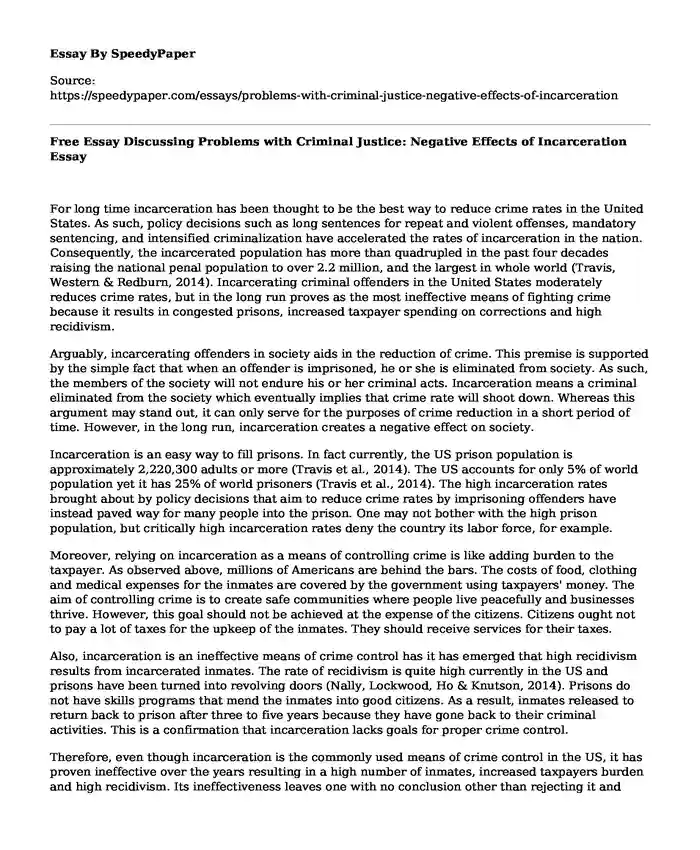
| Type of paper: | Essay |
| Categories: | Penal system Criminal justice |
| Pages: | 3 |
| Wordcount: | 634 words |
For long time incarceration has been thought to be the best way to reduce crime rates in the United States. As such, policy decisions such as long sentences for repeat and violent offenses, mandatory sentencing, and intensified criminalization have accelerated the rates of incarceration in the nation. Consequently, the incarcerated population has more than quadrupled in the past four decades raising the national penal population to over 2.2 million, and the largest in whole world (Travis, Western & Redburn, 2014). Incarcerating criminal offenders in the United States moderately reduces crime rates, but in the long run proves as the most ineffective means of fighting crime because it results in congested prisons, increased taxpayer spending on corrections and high recidivism.
Arguably, incarcerating offenders in society aids in the reduction of crime. This premise is supported by the simple fact that when an offender is imprisoned, he or she is eliminated from society. As such, the members of the society will not endure his or her criminal acts. Incarceration means a criminal eliminated from the society which eventually implies that crime rate will shoot down. Whereas this argument may stand out, it can only serve for the purposes of crime reduction in a short period of time. However, in the long run, incarceration creates a negative effect on society.
Incarceration is an easy way to fill prisons. In fact currently, the US prison population is approximately 2,220,300 adults or more (Travis et al., 2014). The US accounts for only 5% of world population yet it has 25% of world prisoners (Travis et al., 2014). The high incarceration rates brought about by policy decisions that aim to reduce crime rates by imprisoning offenders have instead paved way for many people into the prison. One may not bother with the high prison population, but critically high incarceration rates deny the country its labor force, for example.
Moreover, relying on incarceration as a means of controlling crime is like adding burden to the taxpayer. As observed above, millions of Americans are behind the bars. The costs of food, clothing and medical expenses for the inmates are covered by the government using taxpayers' money. The aim of controlling crime is to create safe communities where people live peacefully and businesses thrive. However, this goal should not be achieved at the expense of the citizens. Citizens ought not to pay a lot of taxes for the upkeep of the inmates. They should receive services for their taxes.
Also, incarceration is an ineffective means of crime control has it has emerged that high recidivism results from incarcerated inmates. The rate of recidivism is quite high currently in the US and prisons have been turned into revolving doors (Nally, Lockwood, Ho & Knutson, 2014). Prisons do not have skills programs that mend the inmates into good citizens. As a result, inmates released to return back to prison after three to five years because they have gone back to their criminal activities. This is a confirmation that incarceration lacks goals for proper crime control.
Therefore, even though incarceration is the commonly used means of crime control in the US, it has proven ineffective over the years resulting in a high number of inmates, increased taxpayers burden and high recidivism. Its ineffectiveness leaves one with no conclusion other than rejecting it and calling for alternative crime control methods. Other methods of crime control that focus on the individual inmate and molding him or her to become a good citizen should be considered.
References
Nally, J. M., Lockwood, S., Ho, T., & Knutson, K. (2014). Post-Release Recidivism and Employment among Different Types of Released Offenders: A 5-Year follow-up Study in the United States. International Journal of Criminal Justice Sciences, 9(1).
Travis, J., Western, B., & Redburn, F. S. (2014). The growth of incarceration in the United States: Exploring causes and consequences. The National Academies Press.
Cite this page
Free Essay Discussing Problems with Criminal Justice: Negative Effects of Incarceration. (2022, Sep 28). Retrieved from https://speedypaper.com/essays/problems-with-criminal-justice-negative-effects-of-incarceration
Request Removal
If you are the original author of this essay and no longer wish to have it published on the SpeedyPaper website, please click below to request its removal:
- Business Plan Essay Example
- Art Essay Sample: The Hidden Emotions in the Images of the Tale of Genji
- Lookism - Free Essay Examplefrom Our Database
- Essay Sample on the Role of Sanctuary Cities and Trump's Policies on the Immigration
- Checking whether All Assumptions Were Tested
- Essay Example on Immigration Issues in the U.S.A
- Essay Example. "Parasite" Film Review
Popular categories




